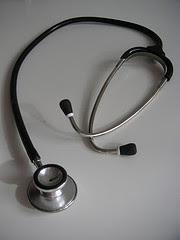Forms to National ID
Forms, forms, forms. Relocating to another country, even temporarily, involves quite a few forms. One of them is a medical report which includes an immunization report.
I got a complete physical yesterday but had a tough time digging up my immunization record. I can't even find my old Steppenwolf records, much less an immunization record.
After calling every single number in the yellow pages under "travel medicine" and still not finding where I got my previous immunizations (recall I had to take the deluxe immunization package when I went to India in 1998), a colleague recalled it was "Associated Internists." Good thing my colleague's memory is so good: I was within milliseconds of calling Guy Noir, Private Eye.
However, using the "Associated Internists" clue and Google I found that they had moved and changed their name to two names: World Wide Travel something and Beacon Medicine. Since my records were more than 2.5 years old, the time they decided to join catch up with the 1990's, my records were hard copy.
So I went down there for my appointment which was a good news bad news thing. The good news is that I'm about as immune as piece of granite and don't even need boosters for another 5 years. I could survive swimming in a vat of yellow fever, the hepatitis alphabet, and malaria bacteria. The bad news is that it still cost me $66 bucks. Who knows what the insurance was billed?
Then I had to take the signed immunization record to my general practitioner who is supposed to fax my complete check up results and immunization record to a doctor in Sweden. Seems like American medicine offers superbly trained doctors and miracle drugs but is still in the dinosaur age in terms of using computers, IMHO. Worse, the concept of fax'ing and mailing the completed forms (and reading the instructions) seemed foreign to my doctor and all her staff. I knew as I saw them shove the forms into my folder (and I'm not talking a computer folder, this one is made of cellulose) I'd have to call back to "make this happen."
Why do I bring this up?
Well, I've always thought we in the US should have a national database with all our medical records accessible by password. Furthermore, people should be able to mine the database for all sorts of medical data. Imagine seeing a map of the United States color coded by density of the flu? or any disease? Imagine seeing it change over time like a movie: from 1980 to present? Imagine how quickly the CDC could discover outbreaks when they used such maps (assuming doctors entered the data: Jo Smo has the flu on such-and-such data and his address is ...) The computer would use the address to place my data on the map. Correlations with weather, food distribution, pollutants, and all sorts of things could be done. Including not having to worry about clinics going out of business or changing their names!
Data is knowledge.
Anyway, it all reminded me of the national number that every Swede has. It's the same number as on their driver's license, simply transferred to the driver's license when the reach driving age. The number it self is coded. The first 8 digits represent their birth date. The next 2 represent the hospital ward they were born in (some hospital's have multiple wards). The next digit represents which birth they were that day. Boys get even numbers and girls get odd numbers (or maybe vice versa). If there are more that 5 girls or 5 boys born that day, there's a procedure for "creating" a new ward. The last digit is called a check-sum digit. It's value is chosen so that the sum of all the digits is a number whose last digit is zero. This is used to greatly reduce human errors when typing in the numbers into computers. Their computers are already programmed to verify the check-sum.
These numbers are tied to what books they check out of the library, their bank-accounts, their medical records, everything. The American Privacy Rights groups would break out in hives if some one in the US even whispered this. In fact, I may be followed by a guy in a trench coat for writing this. Let's keep it between us, ok? Anyway, the national ID sure makes Swedish society work like a well oiled machine.
I have no idea how Sweden protects against identity theft but knowing the clever Swedes, I know they've done something. I hope to find out.
I do know that if they loose their card. They have to get another but it involves receiving mail in separate envelops on different days: kinda sorta like our pin codes for our ATM cards.
There ought to be a way, maybe a voluntary system, in the US for achieve much the same thing (and more, as I mentioned above) and still maintain a modicum of privacy protection. We have the technology.
Perhaps one of my Swedish readers could elaborate on the Swedish id.

















